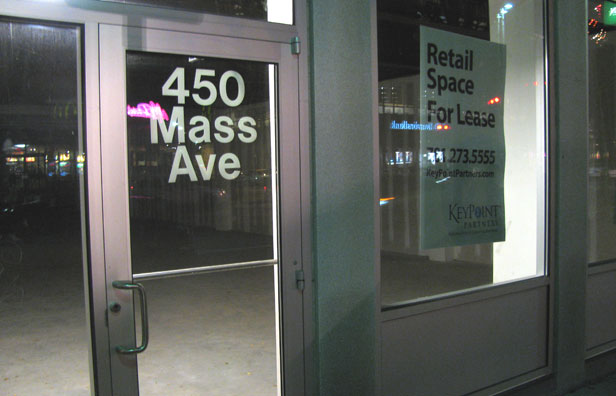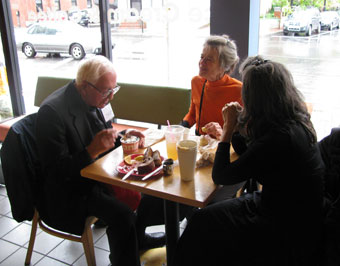Homeless obscure imagining of Central Square’s future

The empty storefront at 450 Massachusetts Ave. should be used for a year-round Central Square fair and farmers market, according to one attendee at a Wednesday forum on the square. (Photo: Marc Levy)
Talk of the homeless dominated Wednesday’s “Central Square: Discussing the Present, Envisioning the Future” forum in direct proportion to how much the homeless dominate Central Square itself — unignorable despite all the stuff going on around them.
So there was plenty of debate, questions and suggestions about the homeless in Central Square at the City Hall forum, attended by about three dozen people, but also reports from surveys about how people feel about the square and what is needed there; ideas for improvements; and a list of possible next steps.
In some ways, the night was eerily reminiscent of the largely failed re-envisioning Harvard Square went through in 2005, although more ideas raised Wednesday have a chance to succeed; the Harvard process seemed constrained by rental rates and Harvard University, which owns 30 storefronts and much else in the square, making decisions based on its own best interests and able to weaken private-sector projects by providing the same services cheaper to its students.
Proposed

Donald L. Unger feasts Oct. 3 on ice cream at Toscanini's in Central Square before giving an Ig Nobel Informal lecture at the Massachusetts Institute of Technology. The ice cream shop has been cited as a reason for people to come to Central Square. (Photo: Marc Levy)
Some ideas were simple, such as enforcing zoning laws that instead of covering over retailers’ display windows with signs, they should actually display things that are for sale or allow peeks inside; or that windows up and down Massachusetts Avenue should share themes; or that windows could have toylike animated displays, drawing families to stroll several blocks for a Macy’s kind of thrill. Or that Central Square — and other sections of the city — could have gates like Chinatown.
Some ideas were a little more complicated, such as blocking off streets (such as Massachusetts Avenue from the post office to Sidney Street) to traffic on Sundays, creating “an arena of happiness,” in the word of homeowner Joan Squeri, for pedestrians to wander, hearing bands and buying wares from artisans.
Some ideas were sort of inchoate, such as political watcher Robert Winters’ wondering if the city could put some sort of unique attraction in Central Square, a destination along the lines of L.A. Burdick Handmade Chocolates in Harvard Square. “It could be something as silly as mini golf,” he said. “But it has to be something you can’t find anywhere else.” (Someone called out an existing business fitting that description: Toscanini’s ice cream.)
Probably the most practical, specific and powerful idea belonged to writer Monica Raymond, who wanted a larger empty storefront, such as the empty 450 Massachusetts Ave. next to the Central Square Theater, to become a year-round, indoor Central Square World’s Fair of artists, music and cheap ethnic cuisine. Gus Rancatore, owner and founder of Toscanini’s, had a further suggestion: that there be night hours, drawing late-night noshers like Boston’s Sami’s falafel cart or Buzzy’s Roast Beef, which shut down when the Charles Street Jail became the Liberty Hotel.
“I’m very gung ho about taking the World’s Fair as a model for what could happen all the time. There could be stalls, combined with a year-round farmers market, so people don’t have to spring for storefronts,” Raymond said.
Determined
The results of the Economic Development survey — 346 people were interviewed over six days in August and September — showed other priorities.
Respondents said they most of all wanted to see, in descending order, more apparel stores in the square, for men, women (plus-sized women were mentioned specifically) and children; theater space, especially a cinema; shoe stores; bookstores; and gift and jewelry shops. In a separate query of what businesses were wanted “in Central Square that are not in here now,” 26.3 percent of respondents wanted apparel stores, 24.1 percent wanted restaurants, 11.9 percent wanted general merchandise stores, 9.7 percent wanted a movie theater and 7.2 percent wanted bookstores. Below that were mentioned a grocery store (6 percent), bakeries (3.8 percent), independent stores (2.8 percent), art galleries (2.2 percent), coffeehouses and cafes (2.2 percent), dollar stores (1.9 percent) and retail (1.9 percent).
That’s one of the things so familiar from the Harvard Square process, where participants asked for resources already in the square — for instance, wishing there were a deli in ignorance of Cardullo’s lunch counter or Darwin’s Ltd. or wishing there were somewhere to buy housewares in ignorance of Crate & Barrel (there at the time) and Dickson Bros. TrueValue Hardware (still there).
In the case of Central Square, almost everything people say they want already exists, including apparel stores, great restaurants, bookstores, coffeehouses and cafes and theater space, although not a cinema.
Reminded

Harvard Square, seen in June 2007, went through a re-envisioning process in 2005. (Photo: Infrogmation)
There were other similarities to the Harvard Square process:
Participants thought the answer to Harvard Square’s problems might lie in better branding. The same idea was brought up Wednesday, when people suggested Central Square could capitalize on its entertainment, including nightclubs, theaters and dining.
A grocery store was demanded in 2005, although Harvard Square had a Sage’s grocery store that died from shoppers’ neglect, and on Wednesday in Central Square there were demands for the kind of clothing shops that had come and gone, including The Gap. “It’s market forces,” artist Carolyn Shipley said. (But Harvard Square has had Market in the Square to serve its grocery needs since late 2007, suggesting market forces are circular.)
The main cry heard by City Hall in October 2005 was that Harvard Square was being overrun by bank branches and losing its soul in the process, and Wednesday there were identical complaints, just one mile down Massachusetts Avenue. The survey showed 9 percent of respondents wanted banks gone from the square, following the removal of public drinking, loitering, homelessness, benches and chain stores, and three speakers Wednesday brought up the bank branch replacing The Gap, all with anger and despair.
“I was kind of mystified by why the Central Square Business Association would work to get them a variance … if people don’t even think they should be in the square. It seems like a prime retail space,” said Gerry Bergman, an Area 4 activist, asking repeatedly, “What’s going on?” He left immediately but was convinced to return for an answer by George Metzger, interim president of the Central Square Business Association. But all Metzger could tell the forum was “I didn’t write that letter” working for a variance for bank signs.
In a related matter, in both venues and in both years there were complaints about rents. Winters asked Wednesday about “price fixing on rents at certain levels that will always be an obstruction to diversity in retail” and others mentioned the need for more affordable options in the square, such as lower-cost coffee shops and a grocer more along the lines of Market Basket than Whole Foods, that could come with lower rents.
Dominated
Homelessness — 60 percent to 73 percent on the “eliminate” portion of the survey — was the main aspect in which Central Square stood apart significantly from the 2005 work on Harvard Square, as overpowering a force in Central as the university is in Harvard. At one point Mayor Denise Simmons tried to keep the meeting focused on ideas by cutting off a comment Shipley was making about the homeless, only to be told by another audience member she was being “heavy-handed.” When that speaker arose, she asked about homelessness.
Most of the comments by Steven Williams, deputy superintendent of the Cambridge Police, were about the homeless, and it was such a crucial issue that another speaker Wednesday was Len Thomas, director of the Brookline Street-based Multi-Service Center. While Shipley said, “Until they get rid of crime and the homeless, [retailers coming here] are wasting their time,” Thomas — amid a torrent of explanation of efforts being taken both to help the homeless and alleviate their presence— said simply, “Homelessness isn’t going to go away.”
Vice Mayor Sam Seidel wrapped up the meeting by listing several possible next steps, including monthly mayoral breakfasts with business owners and service providers such as Thomas; funding a 24-hour drop-in center that could take some homeless off the streets during shopping hours and keep them warm and safe at night; establishing an online “information depot” for the square; asking businesses to adopt and care for “your piece of the square,” as Clear Conscience Café owner Dan Goldstein does; and the creation of a formal Central Square Neighbors Association, in which residents would join businesses in making decisions for the area.
“This is not a one-time thing,” Simmons told attendees in one of the last acts of her mayoral term. “I hope you will stay engaged and stay encouraged.”
Note: This story is slightly edited from the original post.

